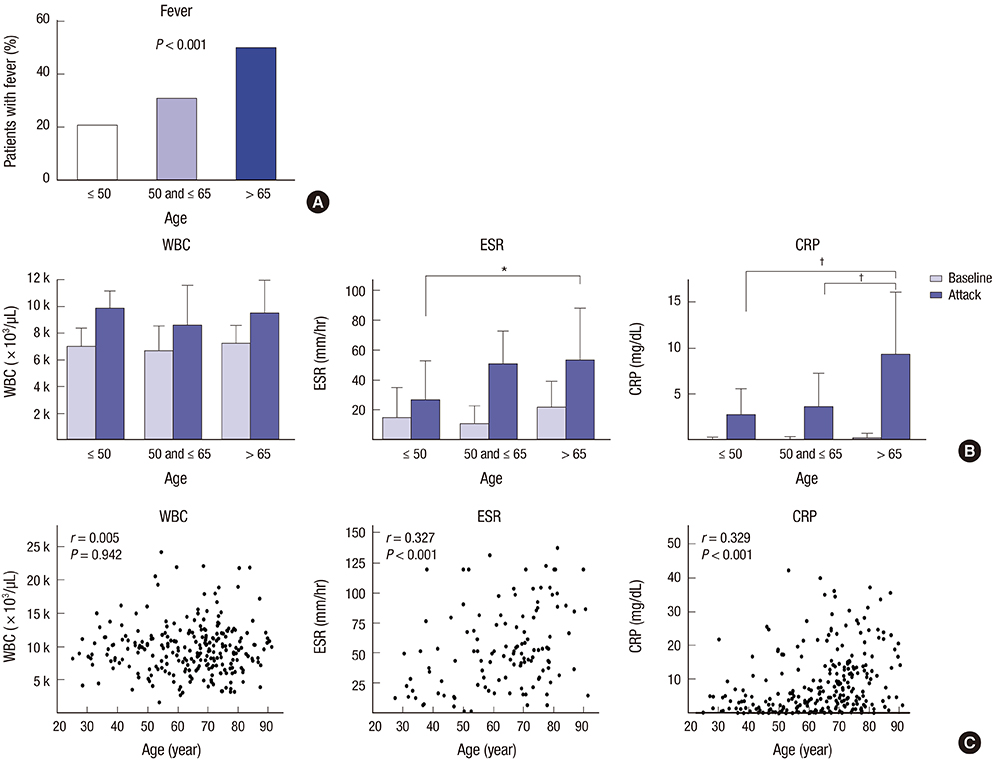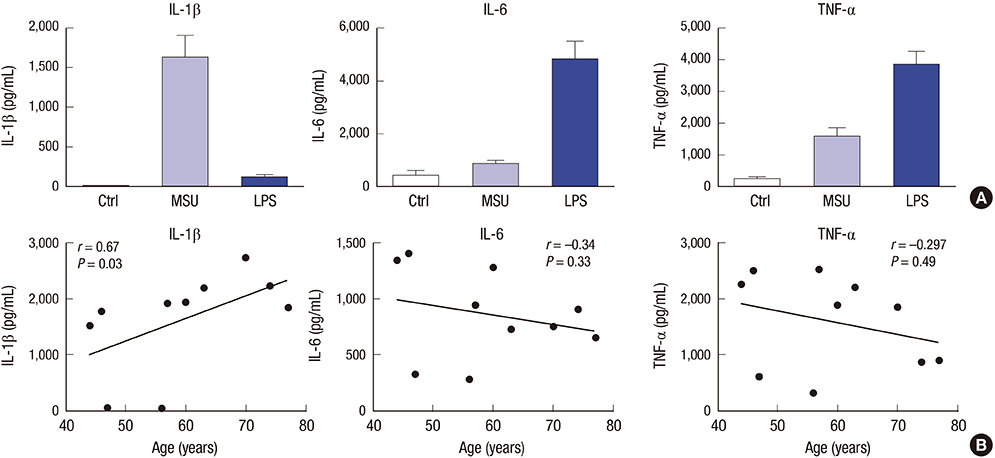J Korean Med Sci.
2017 Dec;32(12):1967-1973. 10.3346/jkms.2017.32.12.1967.
Elderly Patients Exhibit Stronger Inflammatory Responses during Gout Attacks
- Affiliations
-
- 1Department of Internal Medicine, Seoul National University Hospital, Seoul, Korea. jinkyunpark@gmail.com
- 2Department of Internal Medicine, Seoul Metropolitan Government-Seoul National University Boramae Medical Center, Seoul, Korea.
- 3Department of Microbiology and Immunology, Seoul National University College of Medicine, Seoul, Korea.
- 4Department of Biomedical Sciences, Seoul National University College of Medicine, Seoul, Korea.
- 5WCU Department of Molecular Medicine and Biopharmaceutical Sciences, Medical Research Institute, Seoul National University College of Medicine, Seoul, Korea.
- KMID: 2396373
- DOI: http://doi.org/10.3346/jkms.2017.32.12.1967
Abstract
- Gout attacks are often accompanied by systemic inflammatory response. The aim of the retrospective study was to compare gout patients in different age groups in terms of their clinical features at gout attacks. Patients, who were treated for gout attack in two tertiary medical centers between January 2000 and April 2014, were divided into young (≤ 50 years), middle-aged, and elderly (> 65 years) groups. Patients in three age groups were compared in terms of presence of fever (> 37.8°C), C-reactive protein (CRP) levels, and erythrocyte sedimentation ratio (ESR) at the gout attacks. Monocytes, which were isolated from 10 consecutive patients who previously experienced gout attacks, were stimulated with monosodium urate (MSU) crystals and cytokine production was measured by flow cytometry. Among 254 patients analyzed in this study, 48 were young, 65 were middle-aged, and 141 were elderly. The elderly patients were more likely to have fever (51.1%) during the attack than the young (20.8%) and middle-aged (30.8%) patients (P < 0.001 by χ² test). They were also more likely to have higher ESR and CRP levels than the young patients (P = 0.002 for ESR, P < 0.001 for CRP). Patients' age correlated significantly with CRP and ESR levels (both P < 0.001). After stimulation with MSU, the production of interleukin-1β by monocytes increased with patients' age (r = 0.670, P = 0.03). In conclusion, gout attacks in elderly patients are associated with fever and higher ESR and CRP levels, often resembling a septic arthritis.
Keyword
MeSH Terms
Figure
Reference
-
1. Ragab G, Elshahaly M, Bardin T. Gout: an old disease in new perspective - a review. J Adv Res. 2017; 8:495–511.2. Kim JW, Kwak SG, Lee H, Kim SK, Choe JY, Park SH. Prevalence and incidence of gout in Korea: data from the national health claims database 2007–2015. Rheumatol Int. 2017; 37:1499–1506.3. Choi HJ, Lee CH, Lee JH, Yoon BY, Kim HA, Suh CH, Choi ST, Song JS, Joo H, Choi SJ, et al. Seasonality of gout in Korea: a multicenter study. J Korean Med Sci. 2015; 30:240–244.4. Rees F, Hui M, Doherty M. Optimizing current treatment of gout. Nat Rev Rheumatol. 2014; 10:271–283.5. Schett G, Dayer JM, Manger B. Interleukin-1 function and role in rheumatic disease. Nat Rev Rheumatol. 2016; 12:14–24.6. Guerne PA, Terkeltaub R, Zuraw B, Lotz M. Inflammatory microcrystals stimulate interleukin-6 production and secretion by human monocytes and synoviocytes. Arthritis Rheum. 1989; 32:1443–1452.7. di Giovine FS, Malawista SE, Thornton E, Duff GW. Urate crystals stimulate production of tumor necrosis factor alpha from human blood monocytes and synovial cells. Cytokine mRNA and protein kinetics, and cellular distribution. J Clin Invest. 1991; 87:1375–1381.8. van Leeuwen MA, van Rijswijk MH. Acute phase proteins in the monitoring of inflammatory disorders. Baillieres Clin Rheumatol. 1994; 8:531–552.9. Baker DG, Schumacher HR Jr. Acute monoarthritis. N Engl J Med. 1993; 329:1013–1020.10. Ravi Kumar AS, Bui C, Szwarc G, Dixson H. Florid polyarticular gout mimicking septic arthritis. Clin Nucl Med. 2004; 29:262–263.11. Skeete K, Hess EP, Clark T, Moran S, Kakar S, Rizzo M. Epidemiology of suspected wrist joint infection versus inflammation. J Hand Surg Am. 2011; 36:469–474.12. Gleckman R, Hibert D. Afebrile bacteremia. A phenomenon in geriatric patients. JAMA. 1982; 248:1478–1481.13. Manian FA. Fever, abnormal white blood cell count, neutrophilia, and elevated serum C-reactive protein in adult hospitalized patients with bacteremia. South Med J. 2012; 105:474–478.14. Nicholls DW, Rajapakse CN. Systemic inflammatory response syndrome (SIRS) from acute polyarticular gout. N Z Med J. 1999; 112:434–435.15. Wallace SL, Robinson H, Masi AT, Decker JL, McCarty DJ, Yü TF. Preliminary criteria for the classification of the acute arthritis of primary gout. Arthritis Rheum. 1977; 20:895–900.16. Bardin T, Bouée S, Clerson P, Chalès G, Flipo RM, Lioté F, Perez V, Poiraud T, Schaeverbeke T, Richette P. Prevalence of gout in the adult population of France. Arthritis Care Res (Hoboken). 2016; 68:261–266.17. Cassetta M, Gorevic PD. Crystal arthritis. Gout and pseudogout in the geriatric patient. Geriatrics. 2004; 59:25–30.18. Michaud M, Balardy L, Moulis G, Gaudin C, Peyrot C, Vellas B, Cesari M, Nourhashemi F. Proinflammatory cytokines, aging, and age-related diseases. J Am Med Dir Assoc. 2013; 14:877–882.19. Weiskopf D, Weinberger B, Grubeck-Loebenstein B. The aging of the immune system. Transpl Int. 2009; 22:1041–1050.20. Seidler S, Zimmermann HW, Bartneck M, Trautwein C, Tacke F. Age-dependent alterations of monocyte subsets and monocyte-related chemokine pathways in healthy adults. BMC Immunol. 2010; 11:30.21. Sadeghi HM, Schnelle JF, Thoma JK, Nishanian P, Fahey JL. Phenotypic and functional characteristics of circulating monocytes of elderly persons. Exp Gerontol. 1999; 34:959–970.22. Martinon F, Pétrilli V, Mayor A, Tardivel A, Tschopp J. Gout-associated uric acid crystals activate the NALP3 inflammasome. Nature. 2006; 440:237–241.23. Fuster JJ, MacLauchlan S, Zuriaga MA, Polackal MN, Ostriker AC, Chakraborty R, Wu CL, Sano S, Muralidharan S, Rius C, et al. Clonal hematopoiesis associated with TET2 deficiency accelerates atherosclerosis development in mice. Science. 2017; 355:842–847.24. Gasparyan AY, Ayvazyan L, Yessirkepov M, Kitas GD. Colchicine as an anti-inflammatory and cardioprotective agent. Expert Opin Drug Metab Toxicol. 2015; 11:1781–1794.25. Solomon DH, Liu CC, Kuo IH, Zak A, Kim SC. Effects of colchicine on risk of cardiovascular events and mortality among patients with gout: a cohort study using electronic medical records linked with Medicare claims. Ann Rheum Dis. 2016; 75:1674–1679.



